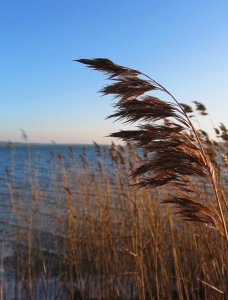Our marshes are teeming with phragmites, the “common reed”, an invasive plant that is generally considered detrimental to a healthy marsh and waterfront. Phragmites out compete native vegetation, lowering biodiversity levels. Nevertheless, some studies suggest that due to its high productivity, limited ability to export litter, and slow decay rates, phragmites might offset problems that rapid sea level rise could pose to many coastal marshes. Further, there is evidence that phragmites might be beneficial in the consumption of nitrogen.
Nevertheless homeowners continue to seek ways to remove 10-15 foot tall plants from their waterfront views. The underground rhizome system of phragmites make it a very difficult plant to eradicate. Eradication with chemicals takes numerous applications over several years. It requires cutting each stem and and applying the herbicide directly into the stem. Like poison ivy, some have concluded that goats may be our best, although perhaps not our most convenient, solution to marsh restoration.
Below is a link to an article recommending an effective way to control phragmites without utilizing chemicals. Herbicides, specifically glyphosates, have been proven to be carcinogenic and harmful to humans and other animals.
Getting Rid of Phragmites Without Dangerous Chemicals
According to Washington State’s Noxious Weed Control Board, getting rid of phragmites without resorting to hazardous chemicals (that will kill other plants and poison the surrounding environment instead of helping it) takes persistence, patience and proper timing: “If cut just before the end of July, most of the food reserves produced that season are removed with the aerial portion of the plant, reducing the plant’s vigor.” The board stresses that such a regime “may eliminate a colony if carried out annually for several years” and that “care must be taken to remove cut shoots to prevent re-growth.”
“Repeated cutting of the green growth above ground will eventually exhaust the root system,” McGrath chimes in. “If the plant is growing in water and you can cut it below the water line and keep the cut area submerged, the root system will suffocate within days…as the plant relies on its stems, living or dead, to convey oxygen down to the roots.”
Yet another option is to graze it out. The New Jersey Division of Fish & Wildlife used sheep, goats and even cattle to control phragmites there, although to be successful the animals needed to graze over affected areas repeatedly, and others have not had as much success with eradication via grazing. Whatever method you choose, hunker down for the long haul and keep up the good fight. You are doing the right thing.
Friends of Barnstable Harbor strongly encourages Cape Cod homeowners and businesses and to seek alternatives to chemicals for all of their gardening, yard and landscaping projects, and especially in the eradication of waterfront invasive species like phragmites.

